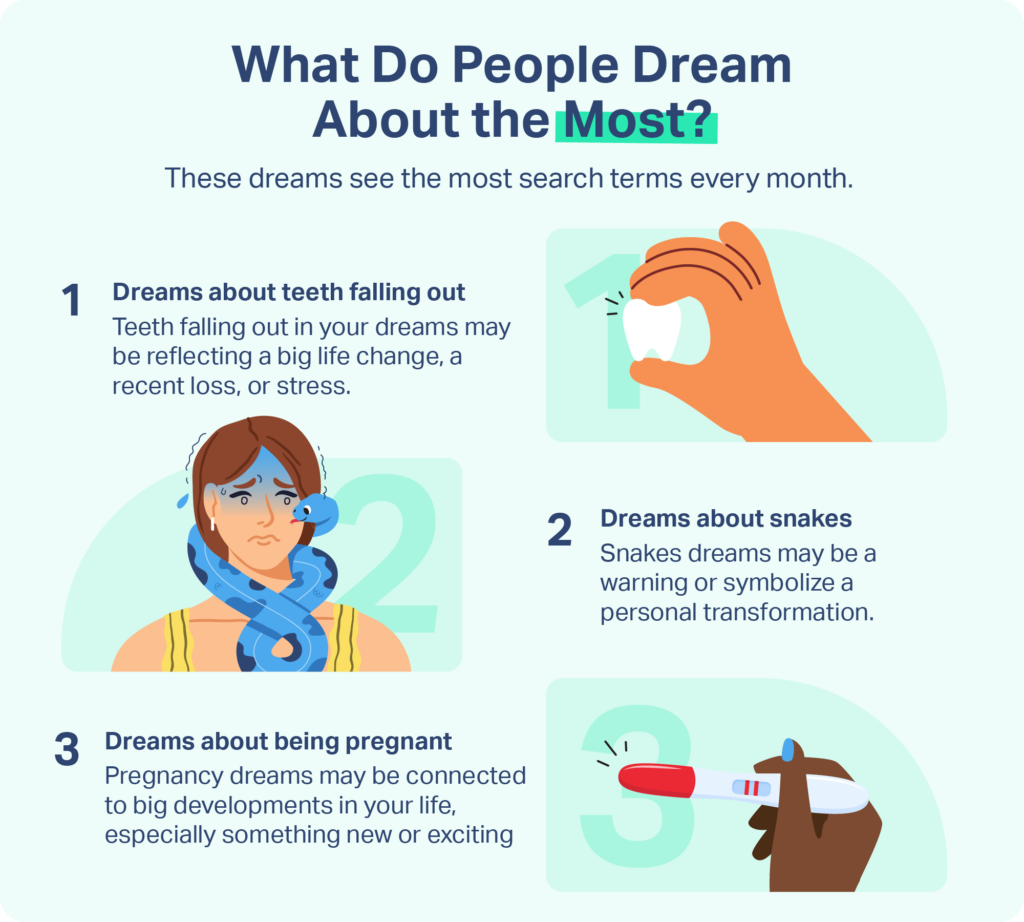How to Interpret Your Dreams
- Scientific research supporting dream interpretation is still relatively new.
- Current theories about dreams suggest that they help with emotional processing, memory consolidation, performance, and creativity.
- Common dream topics include teeth falling out, sex, and falling through the air.
- You can interpret your dreams by remembering common themes, keeping a dream diary, and considering influences in your personal life.
Dreams are a normal part of healthy sleep, with the average person spending around two hours dreaming every night. Despite the amount of time people spend dreaming, there is a great deal researchers still do not understand about the phenomenon. It is still unclear whether individual dreams carry deeper meaning.
Dreams can weave a complex narrative that feels deeply personal. Many people are eager to share the content of their dreams and work to understand their underlying meaning.
We’ll cover the science of dream interpretation, from the psychoanalysts of the early twentieth century to the most recent science-based theories examining the underlying meaning of dreams. We’ll also take a look at the most common dream topics and tips to help with dream interpretation.
Is Your Troubled Sleep a Health Risk?
A variety of issues can cause problems sleeping. Answer three questions to understand if it’s a concern you should worry about.
Theories of Dream Interpretation
People have tried to decipher the meaning of dreams since the dawn of civilization, though scientific research on dreams is relatively new. The most prominent theories of dream interpretation include pioneers from the early twentieth century to modern neuroscientists .
Freud
Freud, the most cited psychologist of the 20th century, published The Interpretation of Dreams in 1900. This book represented a significant milestone in the field of dream interpretation.
According to Freud, dreams represent a form of wish fulfillment and hold the key to a person’s desires. He indicated that the subject of a person’s dreams stems from reality, but dreams are not identical to waking life and cannot be taken at face value. Instead, the underlying meaning of a dream is hidden in a person’s unconscious mind, the thoughts and feelings that lay outside of their conscious awareness.
Jung
Carl Jung was a contemporary of Freud and was greatly influenced by Freud’s Interpretation of Dreams. But as Jung matured, his thoughts on dream interpretation began to diverge from Freud’s.
Jung believed people experience different types of dreams that can be viewed through the lens of “compensation.” According to his theory of compensation, dreams are a mechanism that allow the unconscious mind to fully develop or balance parts that are in conflict with one another.
Hall
Psychologist Calvin S. Hall theorized in the 1950’s that dreams were images that represent a person’s thoughts or ideas. Hall proposed that dreams are akin to plays or enactments based on the ideas a person has about themself, other people, conflicts, impulses and urges, and their external environment.
Hall suggested that dream interpretation could help a person better understand themselves and inform their behavior in daily life.

Domhoff
William Domhoff’s career spanned from the 1960s to the publication of The Emergence of Dreaming in 2018 and combined the analysis of dream content with brain imaging techniques and electroencephalogram (EEG) .
According to Domhoff’s research, dreaming is similar to the daydreams most people experience in waking life. His work suggests that dreams do not serve a specific function and are likely a byproduct of the way the brain works.
Modern Theories
The complex theories developed by early pioneers of dream interpretation have largely been replaced by a neuroscience-focused approach.
- Emotional processing: One prominent theory suggests that the contents of a dream may help the dreamer process difficult life experiences. In particular, the vivid dreams of REM sleep may help the brain process waking experiences and regulate emotions.
- Memory consolidation: Dreaming may also play an important role in forming new memories. This theory asserts that dreams are a key part of the nervous system process that converts short-term memories formed during the day into long-term memories.
- Performance and creativity: According to the overfitted brain hypothesis, the typical experiences of daily life do not prepare the brain for unexpected events. Dreams offer people a hallucinatory narrative that serves to improve cognitive performance and boost creativity during waking hours.
Common Dreams and Possible Meanings
Individual personality and interests can influence the narratives of a person’s dreams. However, certain consistent themes are known to arise in dreams for many different people.
Teeth Falling Out
Dreams about teeth falling out are one of the most common dream narratives. Numerous theories have been proposed to explain the deeper significance of dreams involving teeth.
The ancient Greek Artemidorus believed these dreams could be interpreted based on which specific tooth or teeth a dreamer loses. The early twentieth-century psychoanalyst Sigmund Freud theorized that dreams about teeth had a sexual basis. Other experts have proposed that this type of dream represents anxiety around aging. However, recent research suggests that dental irritation or tension in the jaw while sleeping may contribute to dreams about teeth.

Sex and Cheating
Dream narratives that include sexual content are frequently reported, with more than 70% of people experiencing dreams about sex. These types of dreams may mirror a person’s feelings about sex or reflect unsatisfied desires. Similarly, one study found that dreaming about a cheating partner may be linked to low levels of intimacy or feelings of jealousy in a relationship.
Natural Disasters
Dreams about natural disasters may involve a flood, fire, earthquake, or apocalyptic narrative. Natural disaster dreams may be related to the traumatic events and stressors of a person’s lived experience. People affected by natural disasters such as hurricanes and tornadoes may experience feelings of depression, anxiety, or fear about the storm in the form of nightmares.
Falling
The feeling of falling through the air while dreaming is a frequent theme that has emerged from dream research. Falling is a common sensation people experience before a hypnic jerk. Hypnic jerks are involuntary lurches that can involve a part of the body or the body as a whole.
What Do Nightmares Mean?
Nightmares may signify that a person is struggling with stress, trauma, or a sleep disorder. Nightmares are vivid dream sequences that involve distressing events and often wake a person from sleep. They can invoke feelings of fear and anxiety, but nightmares can also cause embarrassment, anger, and disgust.
Nightmares occur in people of all ages from time to time, though they are more common in children. Occasional nightmares can be disturbing but many people who experience nightmares do not require treatment. They may be a sign that a person is experiencing a stressful life event like a move, starting a new school or job, or having troubles at home.
Other reasons a person may experience nightmares include starting or stopping a prescription medication, the use of illegal drugs, drinking too much alcohol or sudden alcohol withdrawal, using non-prescription sleep aids, or having an illness accompanied by a fever.
People who experience repeated nightmares may want to speak with a health care provider. Frequent, distressing nightmares can be an indication of sleep apnea or another sleep disorder. Persistent nightmares may also be a sign of a mental health condition such as an anxiety disorder, depression, or post-traumatic stress disorder (PTSD).
Tips for Analyzing and Interpreting Your Dreams
Interpreting dreams is far from an exact science. But a few tips can help people better understand their dreams.
- Keep a dream journal: Using a journal or smart-phone app to record your dreams shortly after waking up can help you document the details of your dream. Researchers have used dream journals and dream diaries to help study participants recall their dreams with more accuracy .
- Consider your biases: Research suggests that your interpretation of a dream may be influenced by religious beliefs and interpersonal relationships. When reflecting on a dream, consider whether you are looking for information that confirms your current beliefs.
- Talk with a professional: Consider speaking with a health care professional if you have recurring dreams or nightmares that negatively affect your well-being. These may be a warning sign of another medical condition such as anxiety, depression, or a sleep disorder such as sleep apnea or nightmare disorder. A health care provider can help make a diagnosis and discuss treatment, if needed. If you feel that your particular situation does not warrant the help of a medical professional, you can consider speaking with a sleep consultant. Sleep consultants are trained to handle a number of sleep issues and can guide you in the right direction toward a better night’s sleep.

Still have questions? Ask our community!
Join our Sleep Care Community — a trusted hub of product specialists, sleep health professionals, and people just like you. Whether you’re searching for the perfect mattress or need expert sleep advice, we’ve got you covered. Get personalized guidance from the experts who know sleep best.
References
20 Sources
-
National Institute of Neurological Disorders and Stroke. (2022, April, 1). Brain basics: Understanding sleep.
https://www.ninds.nih.gov/health-information/public-education/brain-basics/brain-basics-understanding-sleep -
Hughes, J. D. (2000). Dream interpretation in ancient civilizations. Dreaming, 10(1):7-18.
https://www.researchgate.net/publication/227247381_Dream_Interpretation_in_Ancient_Civilizations -
Yeung, A. (2021). Is the influence of Freud declining in psychology and psychiatry? A bibliometric analysis. Frontiers in Psychology, 12, 631516.
https://pubmed.ncbi.nlm.nih.gov/33679558/ -
Shaw, B. (2016) Developments in the neuroscience of dreams. Activitas Nervosa Superior, 58, 45–50.
https://link.springer.com/article/10.1007/BF03379951 -
Webb, W. B. (1994). Retrospective review: Sigmund Freud’s The Interpretation of Dreams. Dreaming, 4(1), 54–58.
https://psycnet.apa.org/record/2012-14403-001 -
Zhang, W., & Guo, B. (2018). Freud’s dream interpretation: A different perspective based on the self-organization theory of dreaming. Frontiers in Psychology, 9, 1553.
https://pubmed.ncbi.nlm.nih.gov/30190698/ -
Zhu, C. (2013). Jung on the nature and interpretation of dreams: A developmental delineation with cognitive neuroscientific responses. Behavioral Sciences, 3(4), 662–675.
https://pubmed.ncbi.nlm.nih.gov/25379263/ -
Domhoff, G. W., & Fox, K. C. (2015). Dreaming and the default network: A review, synthesis, and counterintuitive research proposal. Consciousness and Cognition, 33, 342–353.
https://pubmed.ncbi.nlm.nih.gov/25723600/ -
Scarpelli, S., Bartolacci, C., D’Atri, A., Gorgoni, M., & De Gennaro, L. (2019). The functional role of dreaming in emotional processes. Frontiers in Psychology, 10, 459.
https://pubmed.ncbi.nlm.nih.gov/30930809/ -
Wamsley, E. J. (2014). Dreaming and offline memory consolidation. Current Neurology and Neuroscience Reports, 14(3), 433.
https://pubmed.ncbi.nlm.nih.gov/24477388/ -
Nir, Y., & Tononi, G. (2010). Dreaming and the brain: from phenomenology to neurophysiology. Trends in cognitive sciences, 14(2), 88–100.
https://pubmed.ncbi.nlm.nih.gov/20079677/ -
Rozen, N., & Soffer-Dudek, N. (2018). Dreams of teeth falling out: An empirical investigation of physiological and psychological correlates. Frontiers in Psychology, 9, 1812.
https://pubmed.ncbi.nlm.nih.gov/30319507/ -
Shao, X., Wang, C., Jia, Y., & Wang, W. (2020). Sexual dream and family relationships in frequent sexual dreamers and healthy volunteers. Medicine, 99(36), e21981.
https://pubmed.ncbi.nlm.nih.gov/32899040/ -
Clarke, J., DeCicco, T. L., & Navara, G. (2010). An investigation among dreams with sexual imagery, romantic jealousy and relationship satisfaction. International Journal of Dream Research, 3(1), 54–59.
https://journals.ub.uni-heidelberg.de/index.php/IJoDR/article/view/472 -
A.D.A.M. Medical Encyclopedia. (2020, May 10). Nightmares. MedlinePlus.
https://medlineplus.gov/ency/article/003209.htm -
U.S. Department of Health and Human Services. (2022, April 14). Hurricanes and Tropical Storms. Substance Abuse and Mental Health Services Administration.
https://www.samhsa.gov/find-help/disaster-distress-helpline/disaster-types/hurricanes-tropical-storms -
U.S. Department of Health and Human Services. (2022, April 14). Tornadoes and Severe Storms. Substance Abuse and Mental Health Services Administration.
https://www.samhsa.gov/find-help/disaster-distress-helpline/disaster-types/hurricanes-tropical-storms -
Barrett, D., & Luna, K. (2018, December). Speaking of psychology: The science of dreaming. American Psychological Association.
https://www.apa.org/research/action/speaking-of-psychology/science-of-dreaming -
Mangiaruga, A., Scarpelli, S., Bartolacci, C., & De Gennaro, L. (2018). Spotlight on dream recall: the ages of dreams. Nature and science of sleep, 10, 1–12.
https://pubmed.ncbi.nlm.nih.gov/29391838/ -
Nickerson, R. S. (1998). Confirmation bias: A ubiquitous phenomenon in many guises. Review of General Psychology, 2(2), 175–220.
https://journals.sagepub.com/doi/10.1037/1089-2680.2.2.175


















